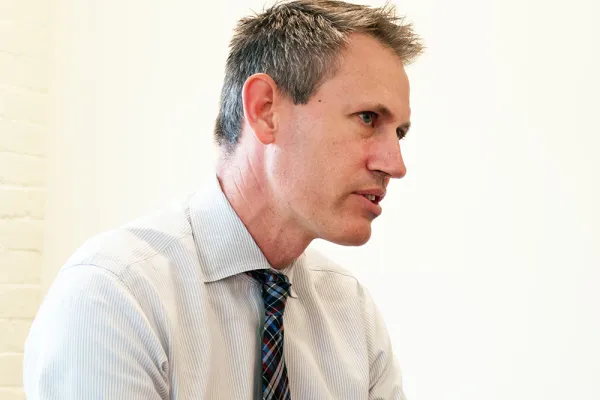Small Is Beautiful: An Interview With New Head of Facilities Roger Mosier
News of Note

Published December 1, 2014
Roger Mosier, who began work in August as associate vice president for facilities management, has posted on his office wall the same campus map that prospective students and other visitors receive.
Although he has access to more sophisticated renderings of the campus, “that’s my favorite map,” Mosier says. “I look at it every day.”
Mosier, who came to Smith after seven years as vice president for facilities at the John F. Kennedy Center for the Performing Arts in Washington, D.C., says he enjoys the variety and scale of buildings at Smith.
“We also have some especially interesting features on campus,” he adds, pointing to exemplars such as Paradise Pond, the Botanic Garden, Ford Hall and the Campus Center.
With more than 180 staff members, Mosier’s department is the largest at Smith.
Facilities Management is responsible for upkeep of 3.2 million square feet of space in 110 academic, administrative and residential buildings on campus. The department also manages capital projects, the central power plant, 33 acres of campus grounds and compliance with government health and safety regulations.
Mosier, who earned his undergraduate and master’s degrees in mechanical engineering from Virginia Polytechnic Institute and State University, says he is eager to “get into every building on campus.”
Here’s what else he had to say in the sixth in a series of interviews with new campus leaders.
How does working at Smith differ from handling facilities at the Kennedy Center for the Performing Arts?
“Although Facilities Management is a large department at Smith and the college itself is bigger than the Kennedy Center, the size of the operation is similar. The main difference is that there are many more technical challenges at Smith because of the diversity of buildings on campus—everything from large athletic facilities to residence halls. Also, having the students on campus makes this work different. There might be 5,000 to 7,000 people on any given night attending events at the Kennedy Center. But here at Smith, we’re taking care of people’s homes. There is more of a community feeling.”
Do you have a favorite building or buildings on campus?
}“I’m attracted to the eclectic nature of the architecture and the variety of buildings on campus. Ford Hall is outstanding, as is the Campus Center. Lyman Conservatory is also phenomenal. I’ve been in John M. Greene Hall and Mendenhall Center and feel some affinity for those buildings from my previous work in performing arts. I’m trying to get inside every building on campus, but I haven’t yet come close.”
What drew you to Smith?
}“I’ve been interested for a while in getting involved in higher education. I worked for 10 years for the Kennedy Center and before that for public schools in Arlington, Va. The Kennedy Center has the largest arts education program in the country, and I enjoy the mission of education. I like that Smith has such a strong reputation and is located in a good community. It’s also an exciting time for the college with so many new administrators. That was a draw as well.”
What key building projects are on the agenda for the near future?
“The biggest is the Neilson Library renovation project. There are a lot of other senior staff involved and a programming committee chaired by Provost Katherine Rowe. It’s an exciting project that has tremendous potential. We’re currently in the process of selecting an architect—the interest in the architectural community in the project has been phenomenal.”
Smith has won national recognition for its environmentally friendly buildings. What will you be doing to expand that work?
“This is an issue I care a lot about, and I like working collaboratively with people on improvements. Sustainability director Dano Weisbord and I have spent a lot of time together assessing what we’ve done and what still needs to be done. My first job out of college was at the Environmental Protection Agency working for Energy Star Buildings, which provides technical support and resources to help building owners become more energy efficient. So I learned lessons about energy efficiency very early in my career. At that time, we weren’t using the word ‘sustainability.’ We were thinking almost exclusively about energy consumption. Over the last 20 years, the focus of this topic has broadened exponentially, and I’m not afraid to say that for me, it’s a constant learning process. At Smith, we’ve already completed a lot of good work in this area, but there is always more to do.”
What is the biggest challenge your department faces?
“The culture of Smith is a culture of small houses and small buildings. That’s a valuable part of the atmosphere on campus. The challenge for Facilities is that we have a lot of old buildings and small buildings to maintain. For example, we’re building new housing on Paradise Road. That project is going to be beautiful. And it’s not going to be one building, as you might have on most other campuses, it’s going to be five. The question now is how do we make sure we build them in the most efficient way—and how do we maintain them?”
Your department has the most staff members of any on campus. What does that mean for your work?
“An operation like this one is all about the people. We have a management structure that we rely on. But the operation really has to focus on the people and how they do their jobs. That’s job one. One thing I’ve found out about Smith is that people really care about the college and their jobs. It’s a pleasant discovery. People really want the campus to look good and work well—they enjoy the mission. Staff members here are very dedicated and take pride and ownership in their work.”
Photo by Shannon Johnson ’15